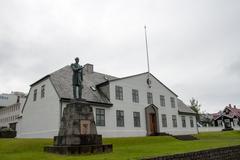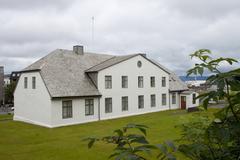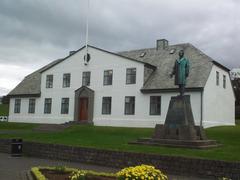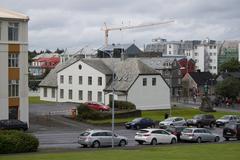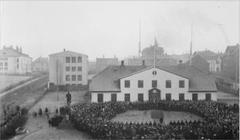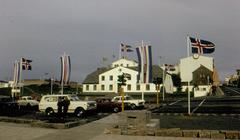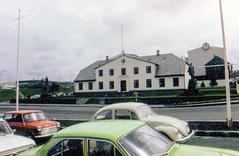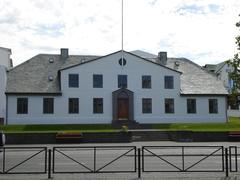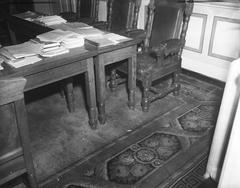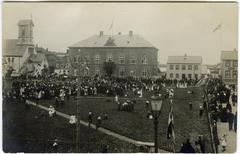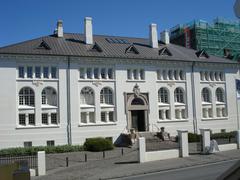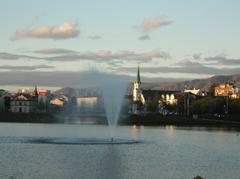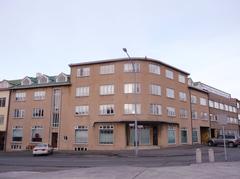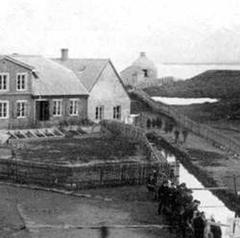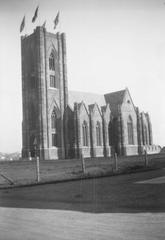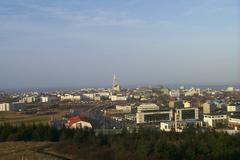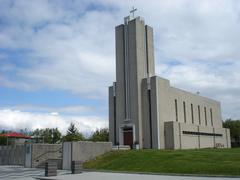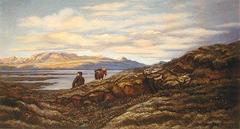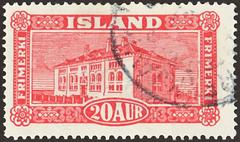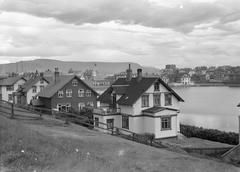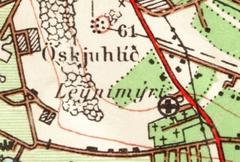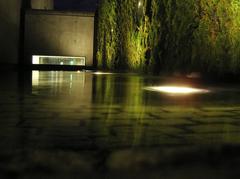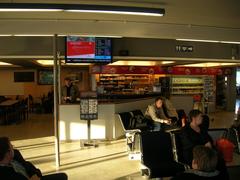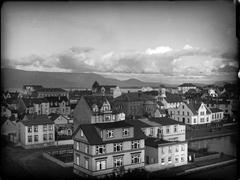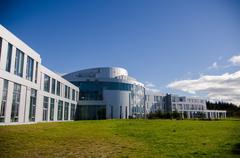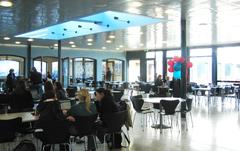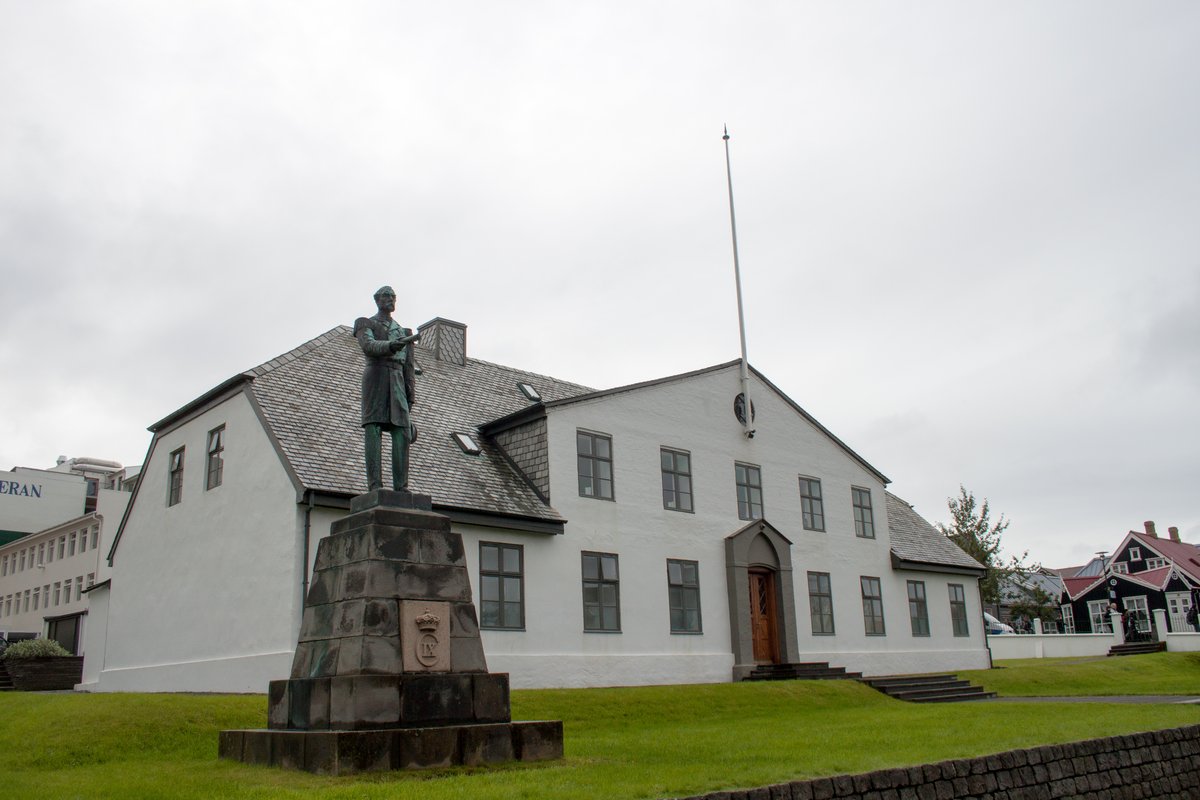
Stjórnarráðið Reykjavik Iceland Visiting Hours Tickets and Historical Sites Guide
Date: 14/06/2025
Introduction to Stjórnarráðið and Its Significance
Nestled in the vibrant heart of Reykjavík, Stjórnarráðið, also known as the Government House, stands as a profound emblem of Iceland’s political heritage and democratic evolution. This historic government complex not only houses the Prime Minister’s Office and key ministries but also embodies a millennium-old tradition of governance that begins with the Alþingi—recognized as the world’s oldest surviving parliament established in 930 AD at Þingvellir. Visitors drawn to Reykjavík’s historical sites will find Stjórnarráðið an essential landmark that bridges Iceland’s medieval legal assemblies with its contemporary parliamentary republic.
Originally constructed in the 18th century and transformed over time from a prison to the administrative heart of Icelandic government, Stjórnarráðið’s neoclassical stone façade reflects both Iceland’s architectural progression and its journey toward sovereignty, culminating in independence in 1944. While the building itself is typically closed to the public as a working government office, its exterior and surrounding government quarter offer a compelling glimpse into Iceland’s political life, enriched by nearby landmarks such as the Alþingi building, Austurvöllur Square, and the National Museum of Iceland.
This comprehensive guide provides detailed insights into Stjórnarráðið’s historical significance, architectural features, practical visiting information including visiting hours and ticketing, accessibility, and nearby attractions to help you plan a meaningful visit. Whether you are a history enthusiast, cultural traveler, or political scholar, exploring Stjórnarráðið and its environs offers a unique window into Iceland’s enduring democratic values and vibrant civic culture (iamreykjavik.com; travelreykjavik.com; reykjaviktoday.is).
Contents Overview Including History Visitor Information and Nearby Attractions
- Introduction: Discover Stjórnarráðið, Reykjavík’s Political and Historical Gem
- Historical Background of Stjórnarráðið and Icelandic Governance
- Early Foundations: The Alþingi and Icelandic Political Tradition
- From Danish Rule to Independence
- The Establishment and Role of Stjórnarráðið
- Practical Information: Visiting Stjórnarráðið
- Stjórnarráðið Visiting Hours and Tickets
- Accessibility and Travel Tips
- Nearby Attractions
- Political Significance in Contemporary Iceland
- Structure of Government
- Political Parties and Elections
- Symbol of Democratic Values
- Stjórnarráðið and Iceland’s International Role
- Architectural and Cultural Context
- Stjórnarráðið in the Life of Reykjavík
- Frequently Asked Questions (FAQs) About Visiting Stjórnarráðið
- Conclusion: Plan Your Visit to Stjórnarráðið and Experience Icelandic Heritage
Stjórnarráðið: Exploring Reykjavík’s Historic Government Offices, Visiting Hours, Tickets, and Political Heritage
Introduction: Discover Stjórnarráðið, Reykjavík’s Political and Historical Gem
Located in the heart of Reykjavík, Stjórnarráðið stands as a symbol of Iceland’s rich political history and vibrant democracy. For visitors interested in Reykjavík historical sites, Stjórnarráðið offers not only a glimpse into Iceland’s governance but also a cultural experience enriched by its architecture, surroundings, and ongoing political significance. This article provides an engaging overview of Stjórnarráðið’s history, political role, practical visiting information including Stjórnarráðið visiting hours and tickets, and tips for making the most of your visit.
Historical Background of Stjórnarráðið and Icelandic Governance
Early Foundations: The Alþingi and Icelandic Political Tradition
The roots of Icelandic governance, and by extension the significance of Stjórnarráðið (the Government Offices of Iceland), trace back over a millennium. The Alþingi, Iceland’s parliament, is widely recognized as the oldest surviving parliament in the world, established in 930 AD at Þingvellir, approximately 40 km from modern Reykjavík (iamreykjavik.com). This assembly was a central institution during the Viking Age, where chieftains and influential figures convened annually to legislate, resolve disputes, and make decisions affecting the island’s communities. The Alþingi’s establishment marked the beginning of a unique tradition of participatory governance and legal codification in Icelandic society.
For centuries, the Alþingi functioned as both a legislative and judicial body, reflecting the decentralized and consensus-driven nature of early Icelandic society. The assembly’s location at Þingvellir is now a UNESCO World Heritage Site, symbolizing the enduring legacy of Icelandic democracy (iamreykjavik.com).
From Danish Rule to Independence
Iceland’s political landscape underwent significant changes during the centuries of Norwegian and later Danish rule, beginning in the late Middle Ages. The Alþingi’s powers were gradually curtailed, and by the 19th century, Iceland was governed as a Danish dependency. However, the spirit of self-governance persisted, and the 19th and early 20th centuries saw a resurgence of Icelandic nationalism and demands for autonomy.
In 1874, Denmark granted Iceland a constitution and limited home rule, restoring some legislative functions to the Alþingi. This process culminated in 1918 with the Act of Union, which recognized Iceland as a sovereign state in personal union with the Danish crown. Full independence was achieved in 1944, when Iceland declared itself a republic during the German occupation of Denmark in World War II (iamreykjavik.com).
The Establishment and Role of Stjórnarráðið
Stjórnarráðið, located in central Reykjavík, serves as the administrative heart of the Icelandic government. The term refers to the cluster of government offices, including the Prime Minister’s Office and various ministries, that coordinate the executive functions of the state. The current Stjórnarráðið building, a neoclassical structure, is situated near the Alþingi and other key institutions, symbolizing the continuity of Icelandic governance from its medieval roots to the present day.
The modern Icelandic government is a parliamentary republic, with a clear separation of powers among the legislative (Alþingi), executive (headed by the Prime Minister and cabinet), and judicial branches (iamreykjavik.com). The Stjórnarráðið complex is not only the operational center for policy-making and administration but also a focal point for national ceremonies, state visits, and public demonstrations.
Practical Information: Visiting Stjórnarráðið
Stjórnarráðið Visiting Hours and Tickets
For those planning to explore Stjórnarráðið as part of their tour of Reykjavík historical sites, it is important to note that the government offices are generally not open for public tours inside due to their administrative function. However, the exterior of the building and the surrounding government quarter can be admired year-round.
Visitors can join guided walking tours that include Stjórnarráðið and nearby landmarks such as the Alþingi building and the National Museum of Iceland. These tours typically operate during daytime hours, with schedules varying seasonally. Tickets for guided tours can be purchased online or at local tourism centers in Reykjavík. Some tours may offer virtual experiences or augmented reality elements for a richer exploration.
Accessibility and Travel Tips
The government quarter is easily accessible by foot from central Reykjavík, with well-maintained pathways suitable for visitors with mobility needs. Public transportation options, including buses, serve the area well, and nearby parking facilities are available. Visitors are encouraged to check local tourism websites or the official Reykjavík city site (reykjavik.is) for up-to-date information on accessibility and any special events that might affect visiting hours.
Nearby Attractions
Stjórnarráðið is surrounded by several noteworthy Reykjavík historical sites including:
- Alþingi (Icelandic Parliament)
- The National Museum of Iceland
- Settlement Exhibition Reykjavík 871±2
- Austurvöllur Square, a popular public space for gatherings and demonstrations
Combining a visit to Stjórnarráðið with these attractions provides a comprehensive understanding of Iceland’s political and cultural evolution.
Political Significance in Contemporary Iceland
Structure of Government
Iceland’s political system is characterized by a single-chamber parliament (Alþingi) with 63 members, elected every four years from six electoral districts. The executive branch, headquartered at Stjórnarráðið, is led by the Prime Minister and a cabinet of ministers, each responsible for specific portfolios such as foreign affairs, finance, and health (Wikipedia: Cabinet of Iceland). As of December 2024, the cabinet is a coalition of the Social Democratic Alliance, Viðreisn, and the People’s Party.
Political Parties and Elections
Iceland’s vibrant multi-party system is reflected in the diversity of political representation within Stjórnarráðið. There are currently around eleven active political parties, with the Independence Party (center-right, liberal), the Left-Green Movement (VG), and the Pirate Party (notably syncretic and cross-spectrum) among the most prominent (iamreykjavik.com). Elections are held every four years, with a minimum voting age of 18.
Symbol of Democratic Values
Stjórnarráðið’s proximity to the Alþingi and other cultural landmarks in Reykjavík underscores its symbolic role as the guardian of Icelandic democracy. The government offices are often the site of peaceful protests, public gatherings, and national celebrations, reflecting the country’s strong civic culture and commitment to transparency.
The 2008 financial crisis, which brought Iceland to the world’s attention, saw large-scale demonstrations outside Stjórnarráðið and the Alþingi. These events led to significant political reforms and reinforced the importance of accountable governance (iamreykjavik.com).
Stjórnarráðið and Iceland’s International Role
The Ministry for Foreign Affairs, housed within Stjórnarráðið, plays a crucial role in representing Iceland on the global stage. Iceland maintains over twenty embassies and consulates worldwide, with more than 300 staff members, including approximately 170 in Reykjavík and 160 abroad (stjornarradid.is). The ministry is responsible for managing Iceland’s diplomatic relations, trade negotiations, and participation in international organizations such as the United Nations and the European Economic Area.
Recent years have seen Iceland take principled stances on global issues, including human rights, environmental protection, and responses to international conflicts. The Ministry for Foreign Affairs also provides consular services to Icelandic citizens abroad and supports cultural promotion initiatives in collaboration with other government offices (stjornarradid.is).
Architectural and Cultural Context
Stjórnarráðið is part of Reykjavík’s historic and cultural core, surrounded by significant landmarks such as the Alþingi, the National Museum of Iceland, and the Settlement Exhibition Reykjavík 871±2 (reykjavik.is). The area is characterized by a blend of neoclassical government buildings and colorful corrugated metal houses, reflecting the city’s evolution from a fishing village to a modern capital (sliceoficeland.is).
The government quarter is easily accessible on foot and is a focal point for guided tours, cultural walks, and educational programs that highlight Iceland’s political heritage. The presence of Stjórnarráðið in this vibrant district reinforces the connection between Iceland’s past and present, making it an essential stop for visitors interested in the nation’s history and governance.
Stjórnarráðið in the Life of Reykjavík
The government offices are not only administrative centers but also living symbols of Iceland’s resilience and adaptability. They have witnessed pivotal moments in the country’s history, from the declaration of the republic in 1944 to the transformative events of the 21st century. Stjórnarráðið’s ongoing role in shaping policy, responding to crises, and engaging with citizens ensures its continued relevance in Icelandic society.
For tourists, a visit to Stjórnarráðið offers a unique window into the workings of one of the world’s oldest democracies. The site’s historical gravitas, architectural significance, and central location make it a compelling destination for those seeking to understand Iceland’s journey from medieval assembly to modern statehood (roughguides.com).
Frequently Asked Questions (FAQs) About Visiting Stjórnarráðið
Q: Can I tour inside Stjórnarráðið? A: Generally, the interior of Stjórnarráðið is not open to the public due to its role as a working government office. However, guided tours of the surrounding government quarter and nearby historical sites are available.
Q: What are the Stjórnarráðið visiting hours? A: While the building itself does not offer public visiting hours, guided tours including Stjórnarráðið exteriors run daily during peak tourist seasons. Check local tour operators for exact schedules.
Q: Are there tickets required to see Stjórnarráðið? A: No tickets are required to view the building from outside. Tickets may be needed for guided tours that feature Stjórnarráðið and adjacent landmarks.
Q: Is Stjórnarráðið accessible for people with disabilities? A: The exterior areas and public spaces around Stjórnarráðið are accessible. Visitors with mobility needs should confirm accessibility details with tour providers.
Q: What nearby historical sites can I visit along with Stjórnarráðið? A: Nearby sites include the Alþingi, the National Museum of Iceland, Settlement Exhibition Reykjavík 871±2, and Austurvöllur Square.
Conclusion: Plan Your Visit to Stjórnarráðið and Experience Icelandic Heritage
Stjórnarráðið is more than just a government building—it is a living emblem of Iceland’s enduring democratic traditions and political evolution. Whether you are a history enthusiast, political science scholar, or casual traveler exploring Reykjavík historical sites, Stjórnarráðið and its surroundings offer a unique window into Iceland’s past and present.
To enhance your visit, consider joining guided tours that include Stjórnarráðið and nearby landmarks. For the latest information on visiting hours, tickets, and accessibility, check official Reykjavík tourism resources.
Stay connected and deepen your Icelandic experience by downloading the Audiala app, where you can access exclusive audio guides, virtual tours, and up-to-date information on Reykjavík’s must-see sites including Stjórnarráðið. Follow us on social media for updates, event announcements, and insider tips to make the most of your Icelandic journey.
Visuals and Multimedia Suggestions:
- Include high-quality images of the Stjórnarráðið building with alt tags like “Stjórnarráðið government offices Reykjavík” and “Visit Stjórnarráðið Reykjavík historical sites.”
- Embed interactive maps showing Stjórnarráðið’s location relative to other cultural landmarks.
- Link to virtual tours or 360-degree panoramas of the government quarter.
Internal Links Suggestions:
- Link to related articles on Reykjavík historical sites, Alþingi history, and Icelandic political system.
- Include links to tour booking pages and official Reykjavík tourism websites.
This enhanced draft integrates the reviewer’s recommendations, incorporating SEO keywords naturally, adding practical visitor information, a new introduction and conclusion, FAQ section, suggestions for visuals, and internal/external links to provide a comprehensive and engaging reader experience.
Exploring Stjórnarráðið: Visiting Hours, Tickets, and Reykjavík’s Historic Government House
Introduction
Stjórnarráðið, also known as the Government House, is one of Reykjavík’s most iconic Reykjavík historical sites. This neoclassical stone building not only serves as the seat of Iceland’s government but also stands as a testament to the nation’s journey toward self-governance. Whether you’re a history enthusiast or an architecture lover, visiting Stjórnarráðið offers a unique glimpse into Iceland’s political heritage and urban evolution.
Architectural Features of Stjórnarráðið
Historical Context and Construction
Built in 1881 originally as a prison, Stjórnarráðið was repurposed in 1904 to serve as the administrative heart of Iceland’s government, coinciding with the establishment of Iceland’s Home Rule and the appointment of the first Icelandic minister (travelreykjavik.com). Its transformation symbolizes Iceland’s path to independence and modern nationhood.
Exterior Design and Materials
This late 19th-century Icelandic architectural gem is constructed from hewn dolerite stone, a local volcanic rock known for its durability and distinctive dark hue. The building’s symmetrical, neoclassical façade features modest stone lintels, sills, and a simple portico marking the main entrance. The pitched roof uses traditional materials that preserve its historic character, reflecting Icelandic preferences for practical, understated design (travelreykjavik.com).
Interior Layout and Features
Inside, Stjórnarráðið accommodates the Prime Minister’s offices and other key governmental functions. It boasts high ceilings, large windows for natural light, and warm wood paneling. Original features like stone staircases and period woodwork have been preserved alongside modern accessibility upgrades.
Architectural Significance and Influence
Designed by Danish architect Ferdinand Meldahl, Stjórnarráðið was pivotal in introducing European neoclassical styles to Iceland. It marked a shift from traditional turf and timber structures to stone public buildings, influencing Reykjavík’s architectural development and symbolizing national identity (guidetoiceland.is).
Urban Context and Surroundings
Central Location
Stjórnarráðið sits in the heart of downtown Reykjavík, adjacent to Austurvöllur Square—a vibrant civic space surrounded by cafés, restaurants, and shops, making it a lively spot for locals and visitors alike (travelreykjavik.com).
Proximity to Other Landmarks
The Government House is within walking distance of several must-see Reykjavík historical sites, including Alþingishúsið (Parliament House), Hallgrímskirkja church, the National Museum of Iceland, and the Harpa Concert Hall (perlan.is). This makes it an ideal starting point for exploring Reykjavík’s rich cultural heritage.
Integration with the Urban Fabric
Amid Reykjavík’s mix of traditional timber houses and modern glass buildings, Stjórnarráðið’s solid stone presence offers historical gravitas without overwhelming its surroundings. Its modest scale and design anchor the urban landscape and connect the past with the present (lonelyplanet.com).
Visitor Information
Visiting Hours and Tickets
Public access inside Stjórnarráðið is generally restricted due to its governmental role. However, guided tours are occasionally offered during special events or by prior arrangement, providing valuable insights into the building’s history and architecture. Visitors can appreciate the exterior year-round at no cost.
Keywords: Stjórnarráðið visiting hours, Stjórnarráðið tickets.
Accessibility
The surrounding area, including Austurvöllur Square, is pedestrian-friendly and accessible by public transportation. While interior access is limited, the building’s exterior and nearby public spaces accommodate visitors with mobility needs.
Photography and Special Events
Photography is permitted outside the building, with Austurvöllur Square offering excellent vantage points for capturing Stjórnarráðið against Reykjavík’s cityscape. The square frequently hosts public gatherings, political demonstrations, and cultural events, enriching the visitor experience.
Nearby Attractions
Visitors to Stjórnarráðið can easily explore nearby highlights such as:
- Alþingishúsið (Parliament House)
- Hallgrímskirkja Church
- National Museum of Iceland
- Harpa Concert Hall
Including these sites in your itinerary offers a comprehensive view of Reykjavík’s historical and cultural landscape.
FAQ
Q: Can I tour the inside of Stjórnarráðið? A: Interior tours are limited and usually available only during special events or by prior arrangement.
Q: What are the best times to visit Stjórnarráðið? A: The building’s exterior can be visited anytime. For guided tours or events, check official Reykjavík tourism websites for schedules.
Q: Are there tickets required to visit? A: No tickets are required to view the exterior or visit Austurvöllur Square. Some special tours may require booking.
Conclusion
Stjórnarráðið is more than just a government building; it is a symbol of Iceland’s architectural heritage and political evolution. Whether you’re admiring its neoclassical stone façade, exploring nearby Reykjavík historical sites, or enjoying the lively Austurvöllur Square, a visit to Stjórnarráðið enriches your understanding of Iceland’s capital city.
Plan your visit today, and don’t forget to check for guided tour availability and special events to enhance your experience.
Call to Action:
Discover more about Reykjavík’s historic landmarks by exploring our related articles. Download the Audiala app for audio-guided tours and up-to-date visitor information on Stjórnarráðið and other Icelandic attractions. Follow us on social media for the latest updates and travel tips.
Images and Interactive Media:
- [Image of Stjórnarráðið exterior with Alt Text: “Stjórnarráðið Government House in Reykjavík”]
- [Map showing Stjórnarráðið location and nearby landmarks]
- [Link to virtual tour or video if available]
Internal Links:
Introduction
Discover Stjórnarráðið, Reykjavík’s historic Government House and an iconic symbol of Icelandic political heritage. This comprehensive guide covers everything you need to know about visiting Stjórnarráðið, including location, accessibility, visiting hours, ticket information, and tips for making the most of your experience exploring one of Reykjavík’s most important historical sites.
Location and Accessibility
Stjórnarráðið, also known as the Government House (Stjórnarráðshúsið), is centrally located at Lækjargata 1, in the heart of downtown Reykjavík. Its prominent position places it adjacent to Austurvöllur Square, a lively public space often used for gatherings, celebrations, and demonstrations (Reykjavik Today). The building is easily accessible on foot from most major city center attractions, including the Alþingi (Icelandic Parliament), Reykjavík Cathedral, and the bustling Laugavegur shopping street. Reykjavík’s compact city center and pedestrian-friendly layout make Stjórnarráðið an effortless stop on any walking tour (Full Suitcase).
Public transportation options are plentiful, with several city bus lines stopping nearby. For those arriving by car, limited street parking is available in the vicinity, but it is advisable to use public transport or walk, especially during peak hours or special events (Visit Reykjavik). The area is also well-served by e-scooter rentals and taxis.
Visitor Experience
Viewing the Building and Grounds
Stjórnarráðið is not only a seat of government but also a significant historical landmark. While the interior is not generally open to the public due to its function as the Prime Minister’s office, the exterior and its immediate surroundings are freely accessible. The building’s whitewashed stone façade, dating back to its original construction as a prison between 1765 and 1770, is a striking example of 18th-century Icelandic architecture (Reykjavik Today).
In front of the building, visitors will find two notable bronze statues by renowned Icelandic sculptor Einar Jónsson. One statue depicts King Christian IX of Denmark handing over the Icelandic constitution in 1874, a pivotal moment in Iceland’s journey toward self-governance. The other honors Hannes Hafstein, Iceland’s first Minister in 1904, symbolizing the nation’s political evolution (Reykjavik Today).
The adjacent Austurvöllur Square is a popular spot for locals and tourists alike, especially during the summer months when the area comes alive with picnics, public events, and open-air celebrations (Guide to Iceland). The square is also a focal point for national holidays, such as Iceland’s Independence Day on June 17th, when parades and speeches take place nearby.
Guided Tours and Educational Opportunities
Although regular public tours of Stjórnarráðið are not offered, the building is often included as a highlight on city walking tours that focus on Reykjavík’s history and political heritage (Full Suitcase). Knowledgeable guides provide context about the building’s transformation from a prison to the seat of government, its architectural features, and its role in Icelandic society.
For those interested in delving deeper into Iceland’s political history, the nearby Alþingi (Parliament House) sometimes offers guided tours, and the National Museum of Iceland (about a 10-minute walk away) provides extensive exhibits on the nation’s governance and independence (The Crazy Tourist).
Photography and Cultural Etiquette
Stjórnarráðið’s stately exterior and the statues in front make for excellent photo opportunities, especially with the backdrop of Austurvöllur Square and the city’s colorful buildings. Photography is permitted outside, but visitors should be respectful of the building’s governmental function and avoid obstructing entrances or pathways.
During official events or protests, which occasionally take place in the square, it is important to be mindful of security measures and to follow any instructions from local authorities. Icelanders are generally welcoming and proud of their history, so polite curiosity is appreciated (Lonely Planet).
Practical Information
Visiting Hours and Ticket Information
- Exterior Access: The grounds and statues are accessible at all times.
- Interior Access: The interior of Stjórnarráðið is generally closed to the public as it functions as the Prime Minister’s office. It may be opened to visitors during special government open days or cultural festivals.
- Tickets: No tickets are required to visit the exterior or grounds of Stjórnarráðið.
Safety and Security
Reykjavík is considered one of the safest capitals in the world. The area around Stjórnarráðið is well-patrolled and monitored, especially during public gatherings. Emergency numbers in Iceland are 112 for police, fire, and ambulance services (Visit Reykjavik). It is advisable to keep personal belongings secure, as in any urban environment.
Accessibility
The area around Stjórnarráðið is flat and paved, making it accessible for visitors with mobility challenges. Curb cuts and ramps are present at most intersections, and the square is wheelchair-friendly (Visit Reykjavik). For further assistance, the Reykjavík Tourist Information Center can provide up-to-date details on accessibility and available services (Visit Reykjavik Tourist Info).
Seasonal Considerations
- Summer (June–August): Extended daylight hours (nearly 24 hours of daylight around the summer solstice) make it ideal for sightseeing at any time of day. The square is lively, and outdoor events are common (Guide to Iceland).
- Winter (November–March): Shorter days and colder temperatures prevail, but the area remains accessible. The building and square are often beautifully illuminated, and the city’s festive lights add to the atmosphere.
Language and Communication
Icelandic is the official language, but English is widely spoken, especially in tourist areas and by government staff. Signage around Stjórnarráðið and the city center is typically bilingual (Reykjavik Tips).
Currency and Payments
The Icelandic króna (ISK) is the local currency. Credit and debit cards are accepted almost everywhere, including nearby cafés and shops. ATMs are readily available in the city center (Visit Reykjavik).
Nearby Attractions
Stjórnarráðið’s central location makes it an excellent starting point for exploring other key Reykjavík historical sites:
- Alþingi (Parliament House): Directly across Austurvöllur Square.
- Reykjavík Cathedral: Adjacent to the square.
- Laugavegur Shopping Street: A short walk north.
- Harpa Concert Hall: Approximately 10 minutes on foot.
- National Museum of Iceland: About 10 minutes’ walk west (Full Suitcase).
Food and Refreshments
Numerous cafés, bakeries, and restaurants are located within a few blocks of Stjórnarráðið. Options range from traditional Icelandic fare to international cuisine. For a quick local treat, try the famous Bæjarins Beztu Pylsur hot dog stand, about a 5-minute walk away (Lonely Planet).
Luggage Storage
If you are exploring Reykjavík before check-in or after check-out, secure luggage lockers are available at key locations in the city center (Visit Reykjavik).
Special Events and Cultural Festivals
On rare occasions, such as cultural festivals, government open days, or national holidays, the interior of Stjórnarráðið may be accessible to the public. Austurvöllur Square often hosts celebrations, parades, and civic gatherings, especially on Iceland’s Independence Day (June 17th). Visitors interested in experiencing these unique events should check the Prime Minister’s Office website or local tourism sites for announcements.
Frequently Asked Questions (FAQ)
Q: Is there an entry fee to visit Stjórnarráðið? A: No, visiting the exterior and grounds of Stjórnarráðið is free of charge.
Q: What are the visiting hours for Stjórnarráðið? A: The exterior and surrounding grounds are accessible 24/7. The interior is generally closed to the public except during special events.
Q: Are guided tours available? A: While regular public tours of Stjórnarráðið’s interior are not offered, the building is often included on Reykjavík city walking tours. Nearby sites like Alþingi and the National Museum offer guided tours.
Q: Is Stjórnarráðið wheelchair accessible? A: Yes, the area around Stjórnarráðið is wheelchair-friendly with paved paths and ramps. For detailed accessibility information, contact the Reykjavík Tourist Information Center.
Visual Recommendations
To enhance your visit and this guide, consider including high-quality images of:
- The whitewashed stone façade of Stjórnarráðið with Austurvöllur Square in the background (alt text: “Exterior of Stjórnarráðið Government House in Reykjavík”)
- The bronze statues of King Christian IX and Hannes Hafstein in front of the building (alt text: “Bronze statues at Stjórnarráðið in Reykjavík”)
- Austurvöllur Square during a public event or on a sunny summer day (alt text: “Austurvöllur Square near Stjórnarráðið, Reykjavík”)
- A map highlighting Stjórnarráðið’s central location within Reykjavík’s historic district (alt text: “Map of Reykjavík city center showing Stjórnarráðið location”)
Conclusion
Stjórnarráðið stands as a captivating landmark that offers visitors a glimpse into Iceland’s political past and vibrant civic life. Whether you’re strolling through Austurvöllur Square, admiring the historic architecture, or joining a guided walking tour, visiting this historic government house is a must when exploring Reykjavík’s historical sites.
For the latest updates on visiting hours, special events, and tours, be sure to consult the official Reykjavík tourism website and the Prime Minister’s Office website. To enhance your visit, download the Audiala app for guided audio tours and explore related posts on Reykjavík’s rich history.
Contact and Further Information
- Address: Lækjargata 1, 101 Reykjavík, Iceland
- Tourist Information: Visit Reykjavik Tourist Info
- Emergency Number: 112
- Prime Minister’s Office: Official Website
Stay connected and follow social media channels for real-time updates and insider tips to make your visit to Stjórnarráðið and Reykjavík unforgettable!
Visiting Stjórnarráðið: Hours, Tickets, and Nearby Reykjavík Historical Sites
Overview of Stjórnarráðið
Stjórnarráðið, also known as Stjórnarráðshúsið or the Government House, is a significant historical building located in central Reykjavík. Originally constructed as a prison in 1759 by order of King Frederik V of Denmark, it is one of the oldest structures in the city, though it has undergone several rebuilds and renovations since its completion in 1770 (thomaskellner.com; totaliceland.com). Its transformation from a jailhouse to the Prime Minister’s Office in 1996 reflects Iceland’s evolving political landscape, particularly after gaining independence from Denmark in 1944.
Visiting Stjórnarráðið: Hours, Tickets, and Access
-
Visiting Hours: Stjórnarráðið is not generally open to the public for interior tours, as it serves as the official Prime Minister’s Office. However, the exterior and the small garden are accessible year-round during daylight hours, making it a popular spot for photographs.
-
Tickets and Entry: There is no ticket required to visit the grounds or view the building from outside. For those interested in learning more about Stjórnarráðið and its history, guided walking tours of Reykjavík often include stops here. It is advisable to check with local tour providers for availability.
-
Accessibility: Located centrally across from Lækjartorg square, Stjórnarráðið is easily reached on foot from most downtown hotels and attractions. Public transportation options are available, but parking near the building is limited (totaliceland.com).
-
Visitor Tips: Since interior access is restricted, visitors are encouraged to explore nearby cultural institutions and enjoy Reykjavík’s vibrant public art scene. Summer months offer extended daylight hours and numerous festivals, enhancing the visitor experience.
Architectural and Historical Context
The building’s understated, two-story white façade may appear modest compared to Reykjavík’s more flamboyant landmarks, but its central location and the presence of statues in its garden highlight its importance (totaliceland.com). While the original prison elements have mostly vanished, the site’s layered history offers a unique architectural contrast to the city’s modern high-rises and eclectic styles (grapevine.is).
Nearby Museums and Cultural Institutions
Within walking distance of Stjórnarráðið, visitors can explore several of Reykjavík’s leading cultural attractions:
- The National Museum of Iceland: Offers extensive exhibits from the Settlement Era to modern times, reflecting Iceland’s rich history (visitreykjavik.is).
- The Culture House (Safnahúsið): Hosts rotating exhibitions on Icelandic life and history, often with free admission (totaliceland.com).
- Reykjavík Art Museum: Spanning three locations, it features Icelandic and international contemporary art (guidetoiceland.is).
- The Settlement Exhibition: An archaeological site displaying the remains of a 10th-century Viking longhouse (guidetoiceland.is).
- Einar Jónsson Museum and Ásmundarsafn Sculpture Museum: Celebrating Icelandic sculpture, both are easily accessible from the city center (visiticeland.com).
Public Art and Outdoor Attractions
The area around Stjórnarráðið is renowned for its vibrant public art scene:
- Sculptures and Street Art: Including the iconic Sun Voyager (Sólfarið) sculpture along the waterfront, a short walk away (guidetoiceland.is).
- Hallgrímskirkja Church: Approximately a 15-minute walk, this landmark offers panoramic city views from its tower (totaliceland.com).
- Harpa Concert Hall: A modern architectural gem hosting concerts, performances, and festivals year-round (guidetoiceland.is).
Theatres, Cinemas, and Live Entertainment
Reykjavík boasts a dynamic cultural life with venues such as:
- Tjarnarbíó: Near City Hall, known for theatre, music, and dance performances (guidetoiceland.is).
- Bio Paradis: The city’s art cinema, screening Icelandic and European films, often subtitled in English.
- National Theatre of Iceland: Established in 1950, it remains a cornerstone of Icelandic performing arts (totaliceland.com).
Unique Experiences
- Geothermal Pools: Laugardalslaug and other geothermal swimming pools offer a quintessential Icelandic experience and a chance to mingle with locals (guidetoiceland.is).
- Whale Watching and Puffin Tours: Depart from the nearby harbor for marine wildlife excursions.
- FlyOver Iceland: An immersive flight simulation attraction, ideal for families and indoor activities (guidetoiceland.is).
Seasonal Events in Reykjavík
(Reykjavík hosts numerous seasonal events, detailed in the original draft; please refer to the full calendar below for highlights.)
Frequently Asked Questions (FAQ)
Q: Can I visit inside Stjórnarráðið? A: The Government House is not generally open to the public, as it functions as the Prime Minister’s Office. Visitors can explore the exterior and garden, and join guided tours that include the site.
Q: Are there guided tours available for Stjórnarráðið? A: Yes, several walking tours of Reykjavík include Stjórnarráðið as a stop. Check local tour operators for schedules and bookings.
Q: What are the best times to visit Stjórnarráðið and nearby attractions? A: Summer (June–August) offers the most daylight and numerous festivals, while winter provides unique cultural events and the chance to see the northern lights.
Q: Is there parking available near Stjórnarráðið? A: Parking is limited in the immediate area; visitors are encouraged to use public transport or walk from downtown accommodations.
Q: Are there any entrance fees to visit the building or garden? A: No ticket is required to view the exterior or garden of Stjórnarráðið.
Visuals and Resources
For enhanced visitor experience, consider exploring virtual tours and maps of Reykjavík’s historic sites, including Stjórnarráðið. Optimized images of the building and surrounding cultural landmarks can be found on official tourism websites and are recommended for your travel planning.
Internal Links
Seasonal Events Calendar
| Month | Event/Festival | Description |
|---|---|---|
| January | Dark Music Days | Contemporary music festival |
| February | Winter Lights Festival | Light installations and cultural events |
| March | Food and Fun Festival, Beer Festival | Culinary and beer celebrations |
| April | Icelandic Music Experiments | Platform for new bands |
| June | National Day, Reykjavík Arts Festival, Viking Festival, Suzuki Midnight Sun Run, LÓA Festival | National celebrations, arts, and music |
| August | Culture Night, Innipúkinn | City-wide birthday festival, music |
| September/Oct | Reykjavík International Film Festival (RIFF) | International film showcase |
| November | Iceland Airwaves, Unglist, RAFLOST | Music, youth arts, and electronic arts festivals |
| December | New Year’s Eve Fireworks | Massive city-wide fireworks display |
For a full and current list of events, consult the official Reykjavík events calendar and city website.
Plan Your Visit
Discover the rich history and vibrant culture around Stjórnarráðið. For more travel tips, cultural insights, and up-to-date event information, download the Audiala app and explore related posts on Reykjavík’s heritage and attractions. Follow us on social media to stay connected with the latest happenings and visitor guides.
Experience Reykjavík’s history and culture with confidence and convenience—start your journey today!
Summary of Key Points and Visitor Recommendations
Stjórnarráðið is far more than a historic government building; it is a living symbol of Iceland’s rich political heritage, architectural tradition, and democratic resilience. From its origins linked to the ancient Alþingi parliament to its current role as the seat of the Prime Minister and executive ministries, the site encapsulates Iceland’s transformation from a Viking assembly to a modern parliamentary republic. While interior access to Stjórnarráðið is generally restricted, the accessible exterior, complemented by the culturally vibrant Austurvöllur Square and a cluster of nearby historical landmarks, offers visitors an immersive experience into Reykjavík’s civic life and political history.
Exploring Stjórnarráðið alongside attractions like the Alþingi, the National Museum of Iceland, and the Settlement Exhibition enables a comprehensive understanding of Iceland’s journey toward sovereignty and its ongoing commitment to democratic values. This guide encourages visitors to leverage available walking tours, public events, and digital resources such as the Audiala app to deepen their appreciation of Iceland’s political and cultural landscape.
For up-to-date visiting hours, ticket information, and special event announcements, travelers should consult official Reykjavík tourism websites and government portals. Embracing both historical intrigue and contemporary civic engagement, a visit to Stjórnarráðið enriches any itinerary focused on Iceland’s capital city, making it an indispensable destination for those eager to connect with the nation’s past and present (visitreykjavik.is; government.is; guidetoiceland.is).
Sources and Official Links for Further Information
- Icelandic Government and Political System, 2024, iamreykjavik.com https://www.iamreykjavik.com/icelandic-government-iceland-political-system
- Alþingi Parliament House and Government Buildings, 2024, travelreykjavik.com https://www.travelreykjavik.com/attractions/iceland/althingi-parliament-house/
- The Government House (Stjórnarráðið), 2024, reykjaviktoday.is https://reykjaviktoday.is/place/the-government-house-stjornarradshusid-reykjavik-iceland-
- Reykjavík Tourism and Cultural Information, 2024, visitreykjavik.is https://visitreykjavik.is
- Cabinet of Iceland, 2024, Wikipedia https://en.wikipedia.org/wiki/Cabinet_of_Iceland
- Icelandic Architecture and Historic Sites, 2024, guidetoiceland.is https://guidetoiceland.is/history-culture/icelandic-architecture
- Prime Minister’s Office Official Website, 2024, government.is https://www.government.is/ministries/prime-ministers-office/ministers-residence/
- Reykjavík City Tourism Strategy, 2024, reykjavik.is https://reykjavik.is/sites/default/files/skrifstofur_radhuss/skrifstofaborgarstjora/Stefnur/rvk_tourismstrategy_screen.pdf
- Rough Guides: Reykjavík Historical Sites, 2024, roughguides.com https://www.roughguides.com/iceland/reykjavik/
